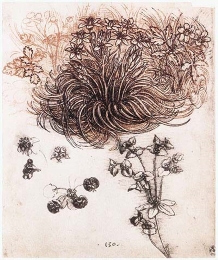Period Band A/B
Making Sense of the World: Art, Medicine, and the Sciences
Tutor: Emanuele Lugli
Description
This module looks at the representation of the physical world from the Great Plague of 1348 to Galileo Galilei’s Scientific Revolution. It will examine the animals sketches made in Milan by Giovannino de Grassi, the drawings of flowers and insects by Pisanello and in 15th-c Dutch Books of Hours, the use of mathematics by Piero della Franceca, anatomical schemes from the late medieval period to Leonardo da Vinci, diagrams of the movements of hydraulic forces and machines, the dazzling fireworks of the 16th-c French court up to the representation of the cosmos and the first steps of connoisseurship in 17th-c Bologna.
Yet, rather than presenting this corpus in evolutionary terms—thus repeating a positivistic narrative—or to see images as mere instances of texts, this module asks questions on how visual culture inspired the sciences and contributed to making sense of the physical world. While providing a historical overview of technical and scientific images between the late medieval and the early modern periods, this module defines and engages with the visual content of key scientific concepts, such as objectivity, clues, and experiments. By linking the late medieval to the early modern periods, this module finally challenges the notion that the early modern period experienced a radical transformation in Europeans’ understanding of the natural world. Rather, it investigates the late medieval tools of many scientific procedures and ideas. The course will thus examine many key scientific episodes (Leonardo’s sketchbooks, the trial of Galileo, Newton’s experiments on light and gravity, Hooke’s studies with the microscope) through critical perspectives developed in recent history of art and science. These include the place of magic and alchemy and the role of collecting and museums in the development of science. In the module students will also examine issues of trust, gender, science as practice and culture, and the public understanding of scientific images in the early modern period.

Module Code HOA00051H
